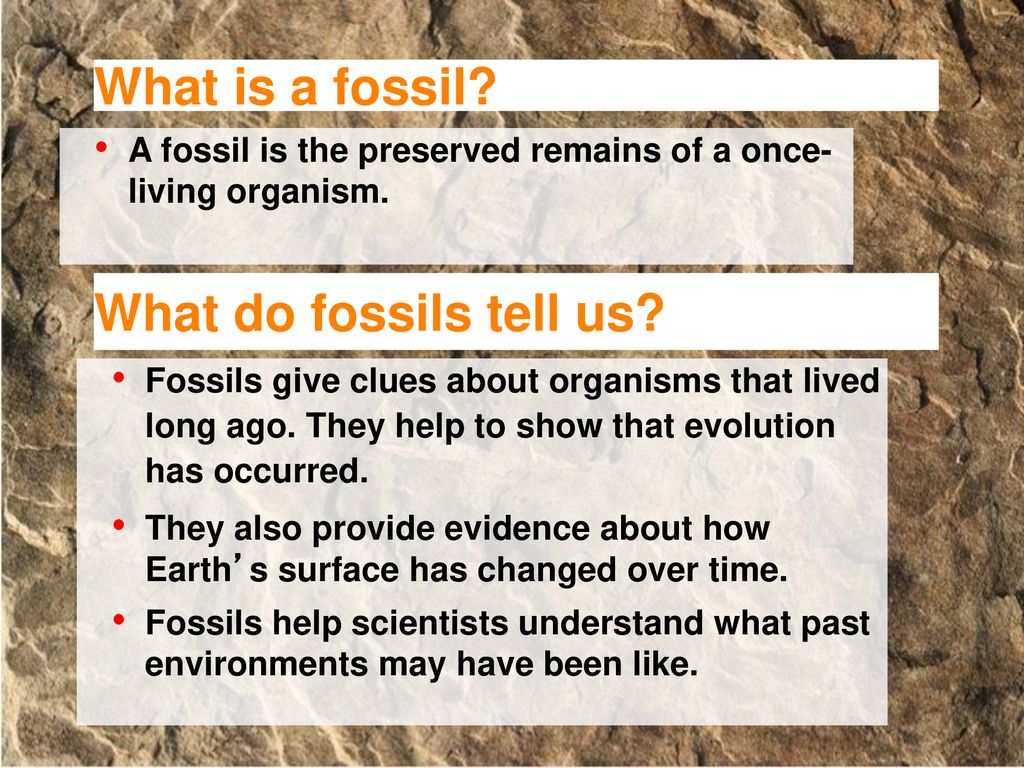Some fossils but only. What can fossils tell us.
 What Can Fossils Tell Us Powerpoint Ks2 Teaching Resources
What Can Fossils Tell Us Powerpoint Ks2 Teaching Resources
Fossils can tell us more than two things.

What can fossils tell us. Fossils tell us a story of life in the past. Make the tracks so they tell a story. These fossils include the freeliving stage of parasites parasites which became fossilised with their hosts parasite eggs and propagules in coprolites and traces of pathology inflicted by.
Examples of data could include type size and distributions of fossil organisms. Press some clay into the Petri dish. In this manner what can fossils tell us about the environment.
Still there is much debate about what our now-extinct ancestors hominins ate. Once people began to recognise that some fossils looked like living animals and plants they gradually began to understand what they were. Despite their rarity there are some fossil parasites which have been described from different geological eras.
Use a pencil to make tracks in the clay. The critical connection between the fossil leaves and the records of CO 2 variation is the photosynthetic process. They formed in the same way our footprints do when walking on soft ground like mud.
Some animals and plant are only known to us as fossils. Fossils give us information about how animals and plants lived in the past. They can tell us in what environment the surrounding rock was formed eg.
So scientists can use this isotopic signature to tell what the climate was doing when the shell formed. Show your fossil story to two classmates at different times. They may also tell us how an organism died usually by rapid burial during a catastrophe.
Objects and fossils are interesting in and of themselves but without context there is only so much we can learn from them. Plants uptake atmospheric CO 2 during photosynthesis through the leaf stomata. They contain many clues about the basic biology of organisms and where and how they lived.
Oxygen can also be used in a similar way although in this case physics and chemistry rather than biology are the dominant forces. Fossil leaves are important archives of CO 2 history in paleoclimate studies. What can fossils tell us about plants animals and environment of the past.
3-LS4-1 Analyze and interpret data from fossils to provide evidence of the organisms and the environments in which they lived long ago. One of the most important contextual pieces is the dating of an object or fossil. The density of leaf stomata is known to correlate with partial pressure of.
By examining the physical characteristics of the fossils we may infer their original size shape method of locomotion diet and even behavior and ecological relations with other organisms and the environment in which they lived. They provide evidence for how living things and the environment have changed over time. Stomata is the epidermis of leaves that facilitate gas exchange.
While fossils reveal what ancient living things looked like they keep us guessing about their color sounds and most of their behavior. Answer the questions below BEFORE you share. Watch the taped instructions oneach of the pages in the example.
Think about the story you want to tell. Click to see full answer. 2Click to begin the activity.
Most studies trying to reconstruct the diet of fossil species focus on teeth from young animals with little wear. Crinoids required still warm sea water rich in plankton. Teeth are almost completely mineral and they fossilize even better than bone so the study of fossil teeth is not new.
The study of the enclosing sediment gives us. Climate sensitivity What a three-million year fossil record tells us about climate sensitivity Understanding how the climate reacts to increasing atmospheric carbon dioxide known as climate sensitivity is crucial to making accurate projections of global temperature rise. Preserved footprints also known as ichnites are a type of trace fossil and a window into the lives of dinosaurs.
Fossils are the preserved remains or traces of a dead organism. Fossils also record the successive evolutionary diversification of living things the successive colonization of habitats and the development of increasingly complex organic communities. Teeth are an important part of our fossil record.
When water evaporates from the ocean at the Earths equator oxygen-18 O18 the heavier oxygen isotope finds it harder to evaporate because it weighs. Certain parts of certain fossils can also tell us about their growth injury disease form function activities and instincts. Fossils have been found in rocks of all ages.
You can make your own fossil story about animals from the past. Fossils give us information about how animals and plants lived in the past. Fossilised bones are some of the most tangible evidence of a dinosaur but they arent the only way to study these prehistoric animals.
Fossils cant tell us everything. Context is a crucial concept in paleoanthropology and archaeology. Kay and his collaborators are developing a new method using micro-CT scans that allows information.
Halaman
T‑Mobile Newsroom
Labels
-
Eye catching graphics and UI. Staring at pregnancy tests day after day to the point where you might even be seeing an imaginary second line...
-
In Land O Lakes ist es den ganzen Tag wolkenlos bei Werten von 5 bis zu 14C. Wetter in Land O Lakes für heute morgen und die Woche. Land ...
-
They change color from greens to brown. On the kitchen sink was a Common Indian Tree Frog or Chunam Tree Frog Polypedates maculatus. Dnr ...
-
This has been the work of several years mostly procrastinating so its something of a relief to finally make it available on Kindle. If you ...
-
Its a must read for youDisability is not inability so goes a famous saying. He has formed an international non-profit organization Life Wit...
